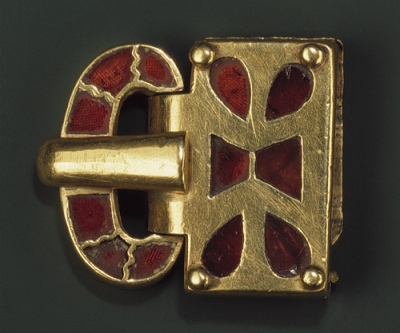Object biographies
Judging the qualities of artefacts from Pitt-Rivers' Farnham collection
It is not always possible to tell the quality of an object, even when the illustrations are as good as those in the Cambridge University Library catalogues. This subject of this webpage looks quite inconspicuous on page 752 of volume three but its history after it left the Farnham Museum has been quite prestigious.
Pitt-Rivers obtained this piece at a sale at Sotheby's in London of items which had been previously owned by Samuel Egger. Egger was an citizen of the Austrian-Hungarian Empire, living in Budapest. He was a dealer, originally he specialised only in rare coins and antiquities but he later expanded his business to include mineral specimens. He seems to have been active from about 1857. By June 1891 he was dead and his collection of 'bronze axes and implements, and ornaments in gold, silver and bronze' wereput up for auction at Sotheby's in London.
The Pitt-Rivers' catalogue states that the item was sold as part of Lot 272 (specifically it was lot 272b). It was described as 'A massive gold belt buckle set with flat pieces of garnet'. It was found with two other objects at Raab (Gyor) in Hungary and Egger had believed it had belonged 'to the period of the Volkerwandering, a migration of barbarian hordes'. The other items from the same hoard were the chape of a sword scabbard, formed by a narrow edging of paste-gilt silver. An ornament at the bottom set with garnets, and some of the beads inlaid with niello. Also a piece of the mouthpiece of the same scabbard set with 3 pieces of garnet, three portions of the silver edging from the same scabbard and a chape of the second sword or dagger.Pitt-Rivers paid £26 for these items, the equivalent in 2008 money of around £12,500 if one uses average earnings asa baseline for the calculation. [1] This was obviously a sizeable sum.
Pitt-Rivers placed all these items directly into his private museum at Farnham, Dorset where they seem to have remained until the middle of the twentieth century. The item at some point seems to have been acquired by Alistair McAlpine, the well-known British collector and then by a dealer, Michael Ward of New York who owned it in 1986 when he sold it to the Metropolitan Museum of New York using funds from various donors including Rogers Fund, Alaistair B. Martin, Norbert Schimmel Foundation, Inc and Levy Hermanos Foundation. The price at this time is unknown. The artefact is part of the Medieval Art and Cloisters collection
The Met describes the object on their on-line record at http://www.metmuseum.org/toah/ho/05/euw/ho_1986.341.htm
"Buckle, 5th century Eastern Germanic or ByzantineGold, garnets; L. 1 3/8 in. (3.5 cm), W. 1 1/8 in. (2.8 cm) ... (1986.341) This buckle, dating from the first half of the fifth century, was discovered in Raab, Hungary. As it was found with silver-gilt and garnet sheath fittings from a battle dagger and sword (now in the British Museum), it may have come from the grave of a prominent leader. The fine workmanship and a rich combination of heavy gold and dark garnets argue that it may have been made in a central jeweler's workshop in Constantinople. Often tribal chieftains from outlying regions of Byzantium were given opulent pieces of jewelry or sword fittings by the emperor, as a sign of friendship and alliance (or as a small bribe). Kings and powerful men would also commission pieces privately from these workshops, as a tangible symbol of their wealth and connections to the powerful civilization in Constantinople, so it is entirely probable that this buckle traveled very far from its maker before being buried with its owner.'
Evans et al, 2001 describe the buckle as being 'discovered near the Danube River, east of Budapest, alongside silver-gilt-and-garnet sheath fittings from a battle dagger and sword ... probably part of the grave goods of a Germanic tribal leader, but the rich combination of gold and garnets and the buckle's fine workmanship suggest it was made by a jeweler in Constantinople. Byzantine emperors frequently gave tribal chieftains from outlying regions opulent pieces of jewelry or weapons fittings as signs of friendship and alliance (or as small bribes). Using money often obtained from the Byzantines, Germanic leaders also commissioned pieces from workshops in Constantinople, displaying them as sybols of their wealth and links with the powerful civilization in Byzantium. It is thus probable that this buckle travelled far from its maker before being buried with its owner'.
So a gold belt buckle may have been made in Istanbul in Turkey, travelled with its Germanic owner in Hungary, been buried in Gyor in Hungary (or Komarom) before being owned by a dealer in Pest, being sold, presumably after his death by Sotheby's and bought by a British general. He displayed it at an obscure private museum in Dorset where it remained for some fifty to seventy years before eventually arriving at one of the most prestigious museums in the world. It has gone from being one of a series of objects found in a hoard on an unprovenanced site to being part of one of the most gilttering collections of medieval art in the world. However the object itself, being made of one of the best lasting of all materials seems scarcely to have altered during all these changes. Its value has increased, the esteem with which it is held has increased, but the artefact itself remains immutable.
Notes
[1] This calculation was performed using a very useful site, http://www.measuringworth.com/ukcompare/
Bibliography for this article
"Buckle [Eastern Germanic or Byzantine] (1986.341)". In Heilbrunn Timeline of Art History. New York: The Metropolitan Museum of Art, 2000 ndash;. http://www.metmuseum.org/toah/ho/05/euw/ho_1986.341.htm (October 2006)
Evans, Helen C., Melanie Holcomb, and Robert Hallman. "The Arts of Byzantium." The Metropolitan Museum of Art Bulletin, v. 58, no. 4 (Spring, 2001).
Alison Petch, Researcher, Rethinking Pitt-Rivers 2010




